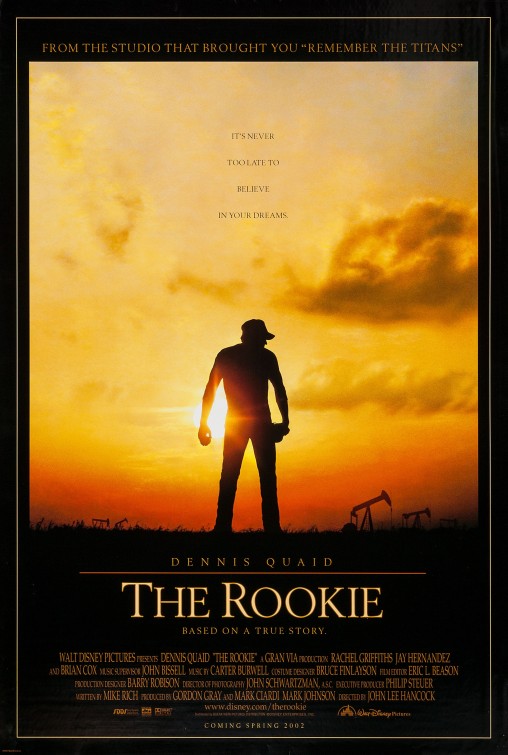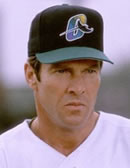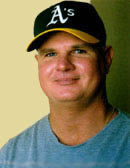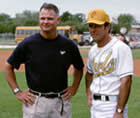A Beautiful Mind is a 2001 American biographical film about John Forbes Nash, the Nobel Laureate (Economics) mathematician. The film was directed by Ron Howard and written by Akiva Goldsman. It was inspired by a bestselling, Pulitzer Prize-nominated 1998 book of the same name by Sylvia Nasar. The film stars Russell Crowe, along with Jennifer Connelly, Ed Harris and Paul Bettany.
The story begins in the early years of Nash's life at Princeton University as he develops his "original idea" that will revolutionize the world of mathematics. Later, Nash develops schizophrenia and endures paranoid and delusional episodes while painfully watching the loss and burden his condition brings on his wife and friends.
The film opened in US cinemas on December 21, 2001. It was well received by critics, and went on to win four Academy Awards, including Best Picture, Best Director, Best Adapted Screenplay, and Best Supporting Actress. It was also nominated for Best Leading Actor, Best Editing, Best Makeup, and Best Score. The film has been criticized for its inaccurate portrayal of some aspects of Nash's life.
Production
Producer Brian Grazer first read an excerpt of Sylvia Nasar's book A Beautiful Mind in Vanity Fair magazine. Grazer immediately purchased the rights to the film.[1] He eventually brought the project to Ron Howard, who had scheduling conflicts and was forced to pass. Grazer later said that many A-list directors were calling with their point of view on the project. He eventually focused on a particular director, who coincidentally was only available at the same time Howard was available. Grazer was forced to make a decision and chose Howard.[1]

From left to right: Director Ron Howard, actor Russell Crowe, producer Brian Grazer, and screenwriter Akiva Goldsman.
Grazer then met with a number of screenwriters, mostly consisting of "serious dramatists", but he chose Akiva Goldsman instead, because of his strong passion and desire for the project. Goldsman's creative take on the project was to not allow the viewers to understand that they are viewing an alternate reality until a specific point in the film. This was done to rob the viewers of their feelings in the same way that Nash himself was. Howard agreed to direct the film based only on the first draft. He then requested that Goldsman accentuate the love story aspect.[2]
Dave Bayer, a Barnard College Professor of Mathematics, was consulted on the mathematical equations that appear in the film. Bayer later stated that he approached his consulting role as an actor when preparing equations, such as when Nash is forced to teach a Calculus class, and arbitrarily places a complicated problem on the blackboard. Bayer focused on a character who did not want to teach ordinary details and was more concerned with what was interesting. Bayer received a cameo role in the film as a professor that lays his pen down for Nash in the pen ceremony near the end of the film.[3]
Greg Cannom was chosen to create the makeup effects for A Beautiful Mind, specifically the age progression of the characters. Russell Crowe had previously worked with Cannom on The Insider. Howard had also worked with Cannom on Cocoon. Each character's stages of makeup were broken down by the number of years that would pass between levels. Cannom stressed subtlety between the stages, but worked toward the ultimate stage of "Older Nash". It was originally decided that the makeup department would merely age Russell Crowe throughout the film. However, at Crowe's request, the makeup purposefully pulled Crowe's look towards the facial features of the real John Nash. Cannom developed a new silicone-type makeup that could simulate real skin and be utilized for overlapping applications, shortening the application time from eight hours to four hours. Crowe was also fitted with a number of dentures to give him a slight overbite throughout the film.[4]
Howard and Grazer chose frequent collaborator James Horner to score the film because of familiarity and his ability to communicate. Howard said, regarding Horner "It's like having a conversation with a writer or an actor or another director." A running discussion between the director and the composer was the concept of high level mathematics being less about numbers and solutions, and more akin to a kaleidoscope, in that the ideas evolve and change. After the first screening of the film, Horner told Howard "I see changes occurring like fast moving weather systems." He chose it as another theme to connect to Nash's ever changing character. Horner chose pop singer Charlotte Church to sing the soprano vocals after deciding that he needed a balance between a child and adult singing voice. He wanted a "purity, clarity and brightness of an instrument" but also a vibrato to maintain the humanity of the voice.[5]
The film was shot 90% chronologically.[6] Three separate trips were made to the Princeton University campus. During filming, Howard decided that Nash's delusions should always first be introduced audibly and then visually. This not only provides a visual clue, but establishes the delusions from Nash's point of view. The real John Nash's delusions were also only auditory. A technique was also developed to visualize Nash's epiphanies. After speaking to a number of mathematicians who described it as "the smoke clearing", "flashes of light" and "everything coming together", the filmmakers decided upon a flash of light appearing over an object or person to signify Nash's creativity at work.[6]
Plot
The film opens with John Nash arriving as a new graduate student at Princeton University. He is a recipient of the prestigious Carnegie Prize for mathematics. He meets his roommate Charles, a literature student, who soon becomes his best friend. He also meets a group of other promising math and science graduate students, Martin Hansen, Sol, and Bender, with whom he strikes up an awkward friendship. Nash admits to Charles that he is better with numbers than people, and that he strives for a truly original idea for his thesis paper. He is largely unsuccessful with the women at the local bar. However, the experience is what ultimately inspires his fruitful work in the concept of governing dynamics, a theory in mathematical economics. After the conclusion of Nash's studies as a student at Princeton, he accepts a prestigious appointment at the Massachusetts Institute of Technology (MIT), along with his friends Sol and Bender.

Russell Crowe as John Nash.
Five years later while teaching a class on Calculus, he meets Alicia, a student with whom he falls in love and eventually marries. While at Princeton, Nash runs into his former roommate Charles and meets Charles' young niece Marcee. He also encounters a mysterious Department of Defense agent, William Parcher. Nash is invited to a United States Department of Defense facility in The Pentagon to crack a complex encryption of an enemy telecommunication. Nash is able to decipher the code mentally. Parcher observes Nash's performance from above, while partially concealed behind a screen. Parcher later encourages Nash to look for patterns in magazines and newspapers, ostensibly to thwart a Soviet plot. After being chased by the Russians and an exchange of gunfire, Nash becomes increasingly paranoid and begins to behave erratically.
After observing this erratic behavior, Alicia informs a psychiatric hospital. Later, while giving a lecture, Nash realizes that he is being watched by a hostile group of people. Although he attempts to flee, he is forcibly sedated and sent to a psychiatric facility. Nash's internment seemingly confirms his belief that the Soviets were trying to extract information from him, and that being taken by the officials of a psychiatric facility was a kidnapping by Soviet agents. Alicia, desperate to help her husband, visits a drop-box and retrieves the never-opened "top secret" documents that Nash had delivered there. When confronted with this evidence, Nash is finally convinced that he has been hallucinating. The Department of Defense agent William Parcher and Nash's secret assignment to decode Soviet messages was in fact all a delusion. Even more surprisingly, Nash's friend Charles and his niece Marcee are also only products of Nash's mind.
After a painful series of insulin shock therapy sessions, Nash is released on the condition that he agrees to take antipsychotic medication. However, the drugs create negative side-effects that affect his relationship with his wife and, most dramatically, his intellect. Frustrated, Nash secretly stops taking his medication, triggering a relapse of his psychosis. While bathing his infant son, Nash becomes distracted and wanders off. Alicia barely manages to save their child from drowning. When she confronts Nash, he claims that his friend Charles was watching their son. Alicia runs to the phone to call the psychiatric hospital for emergency assistance. Charles, Marcee, and Parcher all appear to John and urge him to kill his wife rather than allow her to lock him up again. After Alicia flees the house in terror, Nash steps in front of her car to prevent her from leaving. After a moment, Nash states "She never gets old" as he observes that Marcee is the same age that she was when he first met her several years before. Only then does he accept that all three of these people are, in fact, part of his psychosis.
Caught between the intellectual paralysis of the antipsychotic drugs and his delusions, Nash and his wife decide to try to live with his abnormal condition schizophrenia. Nash attempts to ignore his hallucinations and not feed "his demons". Nash is growing older while working on his studies in the library of Princeton University. He still suffers hallucinations and periodically has to check if new people he meets are real, mentions taking newer medications, but is ultimately able to live with and largely ignore his psychotic experiences. Nash approaches his old friend and intellectual rival Martin Hansen, now head of the Princeton mathematics department, and receives permission to work out of the library and audit classes. He eventually begins teaching again. He is honored by his fellow professors for his achievement in mathematics, and goes on to win the Nobel Memorial Prize in Economics for his revolutionary work on game theory. Later, Nash and Alicia are about to leave the auditorium in Stockholm, when John sees Charles, Marcee and Parcher standing and smiling. Alicia asks John "What's wrong?" John replies "Nothing." With that, they both leave the auditorium.
Cast
- Russell Crowe as John Forbes Nash. A mathematical genius who is obsessed with finding an original idea to ensure his legacy. There was difficulty when casting Crowe, who was well-liked by the producers, when he went to film Gladiator in a different time-zone and was difficult to reach for an extended period of time to attach him to the project.[7]
- Jennifer Connelly as Alicia Nash. A later student of Nash who catches his interest. Connelly was cast after Ron Howard drew comparisons to her and Alicia Nash, both academically and in facial features.[7]
- Paul Bettany as Charles Herman. Nash's roommate and best friend throughout graduate college. The character of Charles was not written to be British. However, director Brian Helgeland provided a tape of Bettany from A Knight's Tale. The filmmakers agreed that the character could be British, based on Bettany's performance in the film.[6]
- Ed Harris as William Parcher. A government agent for the Department of Defense. He enlists Nash to help fight Soviet spies.
- Josh Lucas as Martin Hansen. Nash's rival from his graduate school years at Princeton.
- Adam Goldberg as Sol. A friend of Nash's from Princeton University who is chosen, along with Bender, to work with him at MIT.
- Anthony Rapp as Bender. A friend of Nash's from Princeton University who is chosen, along with Sol, to work with him at MIT.
- Vivien Cardone as Marcee. Charles' niece.
- Christopher Plummer as Dr. Rosen. Nash's doctor at a psychiatric hospital.
- Judd Hirsch as Helinger. The head of the Princeton mathematics department.
Release
A Beautiful Mind received a limited release on December 21, 2001, receiving positive reviews. It was later released nationally on January 4, 2002. Rotten Tomatoes showed a 76% approval rating among critics with a movie consensus stating "The well-acted A Beautiful Mind is both a moving love story and a revealing look at mental illness."[8] Roger Ebert gave the film four stars (his highest rating) in his Chicago Sun-Times review and, along with co-host Richard Roeper on the television show Ebert & Roeper, gave the film a "thumbs up" rating. Roeper also stated "this is one of the very best films of the year." [9] Mike Clark of USA Today gave three and a half out of four stars and also praised Crowe's performance and referred to as a welcomed follow up to Howard's previous film The Grinch.[10] However, Desson Thomson of the Washington Post found the film to be "One of those formulaically rendered Important Subject movies",[8] and Charles Taylor of Salon Magazine gave the film a scathing review, calling Crowe's performance "the biggest load of hooey to stink up the screen this year."[11] The mathematics in the film were well praised by the mathematics community, including the real John Nash.[3]
Also in 2002, the film was awarded four Oscars for Adapted Screenplay (Akiva Goldsman), Best Picture (Brian Grazer and Ron Howard), Directing (Ron Howard), and Supporting Actress (Jennifer Connelly). It also received four other nominations for Best Actor in a Leading Role (Russell Crowe), Film Editing (Mike Hill and Daniel P. Hanley), Best Makeup (Greg Cannom and Colleen Callaghan), and Original Music Score (James Horner).[12] The 2002 BAFTAs awarded the film Best Actor and Best Actress to Russell Crowe and Jennifer Connelly, respectively. It also nominated the film for Best Film, Best Screenplay, and the David Lean Award for Direction.[13] At the 2002 AFI Awards, Jennifer Connelly won for Best Featured Female Actor.[14] The film was also nominated for Movie of the Year, Actor of the Year (Russell Crowe), and Screenwriter of the Year.[15]
Historical accuracy
The film has been criticized for its inaccurate portrayal of Nash's life and schizophrenia as well as for the over-simplified representation of the Nash equilibrium. The filmmakers later stated that the film was not meant to be a literal representation. The difficulty was in portraying stress and mental illness within one person's mind.[16] Sylvia Nasar stated about the film that the filmmakers had "invented a narrative that, while far from a literal telling, is true to the spirit of Nash's story."[17] It made his hallucinations visual and auditory when, in fact, they were exclusively auditory. It is true that his handlers, both from faculty and administration, had to introduce him to assistants and strangers.[18][6] The PBS documentary A Brilliant Madness attempts to portray his life more accurately.[19]
The film had other major departures from Nash's life. No mention is made of Nash's supposed homosexual experiences at RAND.[17] Nash later denounced these accusations.[20] Nash also fathered a son, John David Stier (born 19 June 1953), by Eleanor Agnes Stier (1921-2005), a nurse whom he abandoned when informed of her pregnancy.[21] In 1962, Alicia filed for divorce. It wasn't until Nash won the Nobel Prize that they renewed their relationship.[17]
Nash is shown to join Wheeler Laboratory at MIT, but there is no such lab. He was appointed as C.L.E. Moore Instructor at MIT.[22] The pen ceremony tradition at Princeton shown in the film is completely fictitious.[23][6] The film has Nash saying around the time of his Nobel prize in 1994: "I take the newer medications", when in fact Nash didn't take any medication from 1970 onwards, something Nash's biography highlights. Howard later stated that they added the line of dialogue because it was felt as though the film was encouraging the notion that all schizophrenics can overcome their illness without medication.[6] Nash also never gave an acceptance speech for his Nobel prize.[23] Around the time of the Oscar nominations, Nash was accused of being anti-semitic. Nash denied this and it was speculated that the accusation was designed to affect the votes inside the Academy Awards.[20]
Behind It
Early Life
Nash was born and raised in the state of West Virginia. He was an avid reader of Compton's Pictured Encyclopedia, Life Magazine, and Time magazine. Later he had a job at the Bluefield Daily Telegraph.
At the age of 12, he was carrying out scientific experiments in his room. It was quite apparent at a young age that he did not like working with other people, preferring to do things alone. He returned the social rejection of his classmates with practical jokes and intellectual superiority, believing their dances and sports to be a distraction from his experiments and studies.
Martha, his younger sister, seems to have been a normal child, while John seemed different from other children. She wrote later in life: "Johnny was always different. [My parents] knew he was different. And they knew he was bright. He always wanted to do things his way. Mother insisted I do things for him, that I include him in my friendships... but I wasn't too keen on showing off my somewhat odd brother." [1]
In his autobiography, Nash notes that it was E.T. Bell's book, Men of Mathematics—in particular, the essay on Fermat—that first sparked his interest in mathematics. He attended classes at Bluefield College while still in high school. He later attended the Carnegie Institute of Technology (now Carnegie Mellon University) in Pittsburgh, Pennsylvania on a Westinghouse scholarship, where he studied first chemical engineering and later chemistry before switching to mathematics. He received both his bachelor's degree and his master's degree in 1948 while at the Carnegie Institute.
After graduation, Nash took a summer job in White Oak, Maryland, working on a Navy research project being run by Clifford Truesdell.
Post-graduate life
Though accepted by Harvard University, which had been his first choice because of what he perceived to be the institution's greater prestige and superior mathematics faculty, he was aggressively pursued by then chairman of Princeton University, Solomon Lefschetz, whose offer of the John S. Kennedy fellowship was enough to convince him that Harvard valued him less.[2] Thus, from White Oak he went to Princeton University, where he worked on his equilibrium theory. He earned a doctorate in 1950 with a dissertation on non-cooperative games. The thesis, which was written under the supervision of Albert W. Tucker, contained the definition and properties of what would later be called the Nash equilibrium. These studies led to three articles:
Nash also did important work in the area of algebraic geometry:
His most famous work in pure mathematics was the Nash embedding theorem, which showed that any abstract Riemannian manifold can be isometrically realized as a submanifold of Euclidean space. He also made contributions to the theory of nonlinear parabolic partial differential equations.
In 1951, Nash went to the Massachusetts Institute of Technology as a C. L. E. Moore Instructor in the mathematics faculty. There, he met Alicia López-Harrison de Lardé (born January 1, 1933), a physics student from El Salvador, whom he married in February 1957. Alicia admitted Nash to a mental hospital in 1959 for schizophrenia; their son, John Charles Martin Nash, was born soon afterwards, but remained nameless for a year because his mother felt that her husband should have a say in the name.
Nash and Lopez-Harrison de Lardé divorced in 1963, but reunited in 1970, in a nonromantic relationship that resembled that of two unrelated housemates. Alicia referred to him as her "boarder" and said they lived "like two distantly related individuals under one roof," according to Sylvia Nasar's 1998 biography of Nash, A Beautiful Mind. The couple renewed their relationship after Nash won the Nobel Prize in Economics in 1994. They remarried June 1, 2001.
Nash had another son, John David (born June 19, 1953), with Eleanor Stier, but allegedly had little to do with the child or his mother. However, in a CBS 60 minutes interview aired in March, 2002, the mathematician denied that his relationship with his son from a previous relationship was "non-existent", that in fact he and John Stier are in contact and that Stier even received a share of the film's royalties.
Schizophrenia
Nash began to show signs of schizophrenia in 1958. He became paranoid and was admitted into the McLean Hospital, April–May 1959, where he was diagnosed with paranoid schizophrenia and mild depression with low self-esteem. After a problematic stay in Paris and Geneva, Nash returned to Princeton in 1960. He remained in and out of mental hospitals until 1970, being given insulin shock therapy and antipsychotic medications, usually as a result of being committed rather than by his choice. After 1970, by his choice, he never took antipsychotic medication again. According to his biographer Nasar, he recovered gradually with the passage of time. Encouraged by his then-former wife, Alicia, Nash worked in a communitarian setting where his eccentricities were accepted.
In campus legend, Nash became "The Phantom of Fine Hall" (Fine Hall is Princeton's mathematics center), a shadowy figure who would scribble arcane equations on blackboards in the middle of the night. The legend appears in a work of fiction based on Princeton life, The Mind-Body Problem, by Rebecca Goldstein.
Recognition and later career
In 1978, Nash was awarded the John Von Neumann Theory Prize for his invention of non-cooperative equilibria, now called Nash equilibria. He won the Leroy P Steele Prize in 1999.
In 1994, he received the Nobel Prize in Economics (along with two others), as a result of his game theory work as a Princeton graduate student. In the late 1980s, Nash had begun to use electronic mail to gradually link with working mathematicians who realized that he was "the" John Nash and that his new work had value. They formed part of the nucleus of a group that contacted the Bank of Sweden's Nobel award committee and were able to vouch for Nash's mental health ability to receive the award in recognition of his early work.
Nash's recent work involves ventures in advanced game theory, including partial agency, that show that, as in his early career, he prefers to select his own path and problems. Between 1945 and 1996, he published 23 scientific studies.
Nash also created two popular games: Hex (independently created first in 1942 by Piet Hein), and So Long Sucker in 1964 with M. Hausner and Lloyd S. Shapley.
References

 Jim Morris Video Clip - His Life -
Jim Morris Video Clip - His Life -  Jim Morris on The Rookie -
Jim Morris on The Rookie - 










